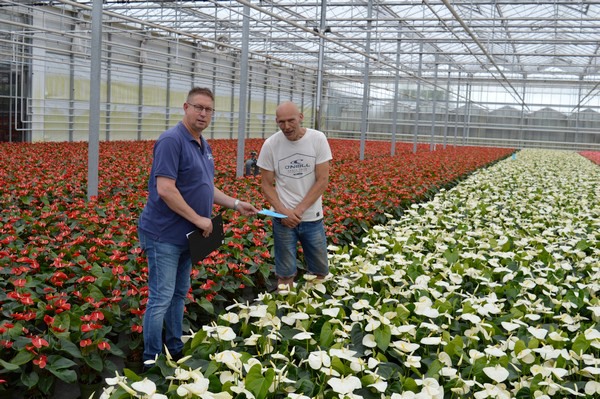At HortiPro, they talk about ‘intensive control'. And that's exactly what it is. It's not done covertly. But because of all kinds of sensitivities also not explicitly. There's a bit more to it than that. Say you have a clear idea of what pests are present in your crop. These could be red spider mites, whitefly, or thrips. And you know how these populations will develop. Then you can anticipate this in your crop protection strategy. And anticipation means improved, more effective use of pesticides. And, so, you save money while becoming more sustainable.

Eric Kerklaan (links) and Leon Breugem.
Generally speaking, you can achieve that by using the correct pheromones. This method is constantly being developed. And it's gradually gaining ground in horticulture. Leon Breugem of Breugem Plants is someone who's benefited from this. He grows anthurium in the Netherlands.
Thrips can be a nuisance for these kinds of flowers. That's the Californian (Frankliniella Occidentalis) but especially the so-called pepper (Thrips Parvispinus) thrips. You can control most thrips with nematodes. However, these worms don't have much effect on pepper thrips. If these thrips appear, there's nothing else to do than to correct selectively.
Tactic
But, a plan was hatched with Eric Kerklaan of HortiPro's help. They hung several sticky traps throughout Leon's greenhouse. Some are fitted with a 'spike', a small tube containing non-selective thrips pheromones. This substance is a specific 'sex substance'. But it's been developed in such a way that both males and females are attracted to it.
These sticky traps should therefore attract significantly more thrips than the standard sticky trap. And indeed, the differences are vast. The two men have been counting how many of these critters are caught and comparing the results. They've been at this every week for more than a year.
This control method led to several conclusions. Firstly, it gives a more up-to-date, accurate picture of the current plague development. A particular pest may or may not be present. Its numbers may be declining or increasing. And that may be at a moderate or alarming rate. Translate that to Breugem Plants' situation. Leon could, for example, establish that a small pepper thrips population was maintaining itself throughout the winter.
He was also able to make a more targeted assessment of when to deploy additional/new biological controls. These controls include Steinernema Feltiae nematodes against thrips. And Aphidoletes Aphidimyza aphid midges against aphids. They then had more time to establish themselves and go to work. And spraying with chemicals could partially or even completely be omitted. If the chemical correction was suddenly needed, in the worst case, Abamectin was applied.
Improved plant quality
The trial has been running for more than a year. It's, of course, a learning curve. But Leon's already convinced of this method's effect and usefulness. "At times in the past, the pest pressure was high. Then we'd have to cut several leaves from the plant. That takes work, and it significantly lowers the plants' quality. Since we've been doing the pheromone controls, we've not had to do that."
Eric, too, is pleased with the test results. "There are few sticky traps. They, therefore, really only serve as an indication. However, based on that data, the grower has already seen marked improvements in his crop. He's using considerably fewer pesticides too. For us, it was also interesting to map the wave pattern. And to be able to conclude that our findings lead to good results. That's combined with our shared knowledge of pest development and control," he concludes.
For more information:
HortiPro
Website: www.hortipro.net
Eric Kerklaan
Email: [email protected]
 Breugem Plants
Breugem Plants
Website: www.breugemplants.nl
Leon Breugem
Email: [email protected]
